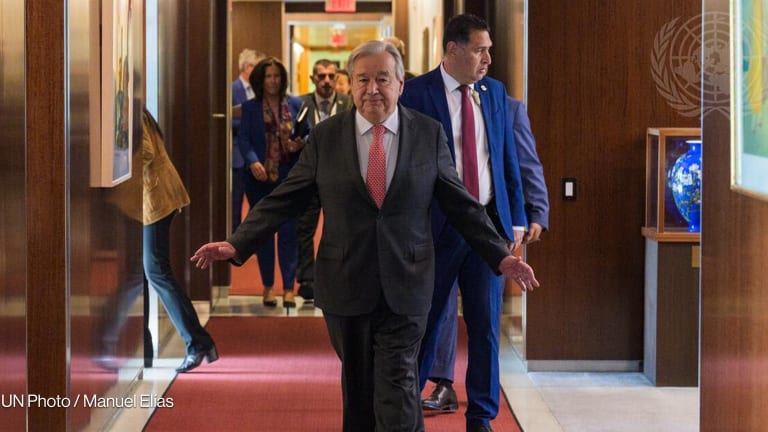For IDB, no easy path to reform
Five years ago, the Inter-American Development Bank's underwent a reorganization — with mixed results, a highly sensitive internal review now finds. Does it have a point, and what may the World Bank and other multilaterals learn from it? An exclusive analysis.
As the leaders of the World Bank undertake the largest reform effort at that institution in nearly two decades, they might do well to look across town to another development bank assessing the impact of its own major reforms. The reorganization of the Inter-American Development Bank which started in 2006 aimed to cement the bank’s relevancy with client countries, and was arguably more ambitious than the World Bank’s current revamp. But eight years later, a report by IDB’s Office of Oversight and Evaluation finds that the reorganization has fallen short of its goals. The report was quietly released last month, and the bank has been tight-lipped about its response, but the findings could have broad implications for decisions about the bank’s management going forward. The reforms — dubbed a “realignment” — are still fresh in the memories of many employees at the Washington-based financial institution as they involved a large number of staff cuts and the turnover of almost all of the bank’s management team. It bore the signature of President Luis Alberto Moreno, who had just been elected to lead the institution. The measures were meant to improve both the technical expertise and country focus of the bank, strengthen results and risk-based management, and improve institutional efficiency. The recent evaluation focuses on the implementation of three of those goals; the bank’s efforts to implement results and risk-based management was examined last year. While the report recognizes progress made in all three areas, it finds significant areas of weakness and calls for a deepening of the bank’s efforts to achieve its goals. In one of the clearest examples of the realignment’s perceived shortcomings, evaluators suggest that given the high direct and indirect costs of the reforms, “it is difficult to make a clear case that the Realignment has improved institutional efficiency overall.” That conclusion is one of many which bank management takes exception to in its official response to the report, saying that the committee ignored clear evidence to the contrary, namely the significant growth in the bank’s portfolio since 2007, while the overall administrative budget has remained stable. Bank management’s lengthy response to the report is full of critiques of the evaluation committee’s methodology and the conclusions it comes to. Addressing the issue of the bank’s structure, management acknowledges “some rebalancing is needed” between the country offices and the technical offices, but goes on to say that the conclusion that “‘the matrix is not yet functioning efficiently and effectively’ appears extreme and runs contrary to several of the evaluation’s own findings discussed in the report.” Management also argues that evaluators did not adequately consider how the bank operated before the realignment or recognize the lively debate that took place at the bank during the recapitalization of the bank in 2009. “It was kind of a difficult discussion, I think it's fair to say,” said Cheryl Gray, the director of OVE. “There was a lot of disagreement at the early stages, not so much on the big principals, but on some of the details and some of the analysis.” Despite the differing conclusions, bank leaders have accepted four out of the report’s five recommendations. The bank will now prepare action plans to implement those four recommendations and present them to the board later this summer. Those recommendations include measures to help strengthen country offices, prevent the “siloing” of the various sectors at the bank, and improve quality control to ensure the development effectiveness. The report has been a sensitive issue for the bank’s leadership, as it could have large implications for management decisions going forward. Even the public release of the document required negotiation, reportedly requiring multiple hours-long meetings of the bank’s board of directors to discuss specifics of the public release of the document. "No one likes to be judged, but this is an important function of the bank and one that was agreed to by all the shareholders many years ago, and it's something that, I think, management takes very seriously,” said Gustavo Arnavat, the former U.S. executive director of the bank, who called the evaluation "a process of give and take." The mixed success could be seen as a blemish on the record of Moreno since it was an important part of his agenda to remake the bank for the 21st century. But Arnavat doesn’t think the evaluations will be an obstacle for Moreno, who will be up for reelection by the bank’s board of governors in 2015. “I think it's actually an opportunity for him to seize and for him to be able to respond in an effective fashion and address the issues that were raised by OVE and, at this point, I would assume have been raised by various shareholders," he suggested. The fifth recommendation of the report — that management use competitive processes to fill more of its positions for senior management — was not accepted by the bank’s leadership, and the bank’s board has decided not to require management to address it. A goal of the realignment was to have 100 percent of senior management positions filled through a competitive process, although what that means exactly seems to be another bone of contention between the evaluation committee and management. Currently, about 40 percent of those positions are filled that way, the rest are appointed by the president. A press officer at the IDB told Devex that bank management had no comment on the report. As for specific lessons for the World Bank from the evaluations findings, Gray — who worked at the World Bank for 23 years — said that in addressing issues of collaboration and siloing, the World Bank is going in the opposite direction of the IDB by creating strong, globally-focused technical offices. And she sees the experience of IDB’s sector-specific offices, which have been very strong relative to country teams, as a cautionary tale. "They really need to be careful,” Gray said about the World Bank’s plan to launch several technically focused global practices by July 1, “because it's very easy to get in silos where you are pushing your own interests, and you kind of lose this cross-sectoral country approach that the World Bank had quite well in the regions, until now.” What do you think about recent IDB reforms — and what can the World Bank and other multilateral institutions learn from its example? Let us know by leaving a comment below. Join the Devex community and access more in-depth analysis, breaking news and business advice — and a host of other services — on international development, humanitarian aid and global health.
As the leaders of the World Bank undertake the largest reform effort at that institution in nearly two decades, they might do well to look across town to another development bank assessing the impact of its own major reforms.
The reorganization of the Inter-American Development Bank which started in 2006 aimed to cement the bank’s relevancy with client countries, and was arguably more ambitious than the World Bank’s current revamp. But eight years later, a report by IDB’s Office of Oversight and Evaluation finds that the reorganization has fallen short of its goals. The report was quietly released last month, and the bank has been tight-lipped about its response, but the findings could have broad implications for decisions about the bank’s management going forward.
The reforms — dubbed a “realignment” — are still fresh in the memories of many employees at the Washington-based financial institution as they involved a large number of staff cuts and the turnover of almost all of the bank’s management team. It bore the signature of President Luis Alberto Moreno, who had just been elected to lead the institution.
This story is forDevex Promembers
Unlock this story now with a 15-day free trial of Devex Pro.
With a Devex Pro subscription you'll get access to deeper analysis and exclusive insights from our reporters and analysts.
Start my free trialRequest a group subscription Printing articles to share with others is a breach of our terms and conditions and copyright policy. Please use the sharing options on the left side of the article. Devex Pro members may share up to 10 articles per month using the Pro share tool ( ).
Paul Stephens is a former Devex staff writer based in Washington, D.C. As a multimedia journalist, editor and producer, Paul has contributed to the Los Angeles Times, Washington Monthly, CBS Evening News, GlobalPost, and the United Nations magazine, among other outlets. He's won a grant from the Pulitzer Center on Crisis Reporting for a 5-month, in-depth reporting project in Yemen after two stints in Georgia: one as a Peace Corps volunteer and another as a communications coordinator for the U.S. Agency for International Development.








